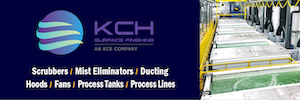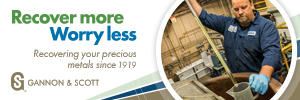Mechanical plating is also referred to as peen plating and is essentially a tumbling process by which metallic specks of dust are deposited onto a metal substrate.
 Stephen Rudy CEFThe process entails the use of special additives and a unique series of steps in the cycle.
Stephen Rudy CEFThe process entails the use of special additives and a unique series of steps in the cycle.
The terms cold-welded and bonded are used to describe the mechanism. Normally, parts for conventional barrel plating can also be mechanically plated. Deposited metals may include zinc, copper, tin, precious metals (e.g., gold and silver), aluminum, and cadmium. Coated substrates include ferrous castings, copper, and stainless steel.
Each step in the cycle differs in varying degrees compared to conventional surface preparation, plating, and post-finishing. The biggest and most critical difference is using fresh makeup for each step in the cycle.
The vessel is similar to an oblique tumbling barrel and is the primary process “tank.” It is typically stainless steel lined with rubber, neoprene, or similar effective protection from acid solutions and to be abrasion resistant. The actual working volume is ¼ to 1/3 of the total barrel volume.
A Typical Cycle
1. Parts cleaning. This step is usually accomplished in bulk, offline. Traditional hot alkaline cleaning, mechanical washer, or solvent cleaning are employed as to effectiveness, availability, and economic feasibility, as are most common to the importance of first-step cleaning parts. Alternatively, the parts can be tumble cleaned in the mechanical plating barrel. Satisfactory cleaning, having been achieved, proceeds to the next step.
2. Surface conditioning I. This critical step utilizes the action of a special chemical additive and media. The balanced chemical and mechanical action develops a part surface free of rust and scales. The chemical additive consists of surfactants, inhibitors, and inorganic acids. Media is present as glass beads. These are typically available in millimeter diameters, commensurate to facilitate effective surface treatment in the general process cycle. It is important to select media that will not lodge in parts. A wide range of media sizes is available for many types of parts that are mechanically plated. In general, each ft3 of a load of parts requires one ft3 of media. The media offers a relatively long service life, contributing very little friction to the operating process.
3. Surface conditioning II. This step completes the critical treatment by depositing a thin, tightly adherent copper film. The deposition of copper promotes a uniform surface metal profile. It also forms a mechanical barrier between the basis metal and hydrogen. (Time, 2-7 min)
4. Promoter or accelerator. This solution consists of a proprietary additive. It standardizes conditions for the deposition of the metal of choice. The promoter controls the agglomeration of the yet-to-be-deposited metal powder and maintains surface cleanliness. (Time, 2-3 min)
5. Flash coat. This is the first addition of metal powder to be deposited. Typically, the powder is zinc, as zinc is the most common mechanically-deposited metal. The flash coat rapidly covers the copper layer with active sites of zinc, readily accepting additional layers of this metal deposit. (Time, 4-7 min)
6. Deposition build-up. Based on the thickness requirement, sufficient additions of metal powder are made. Usually, 2-4 min are allowed between additions. This promotes uniformity of metal thickness on parts, with accompanying deposit smoothness across the entire barrel load. It is critical that the pH of the deposition solution is maintained below 2.0. The proprietary system provides this feature in the process.
7. Rinse.
8. Retrieve. Parts are separated from the media and collected for post-plate finishing.
9. Post-finishing. Chromate, sealer, lacquer, waxes.
10. Dry.
The operating cycle uses a fresh makeup solution for each step, eliminating carryover or re-use of contaminated solution. Segregating parts in the same barrel eliminates their loss since nothing is transferred until the cycle is complete. The solution for steps 2 thru 6 is preferred at 65°F -85°F (18°C -29°C).
Some process development is required to determine the optimum conditions for steps 2 thru 6. Metal powder requirements for deposit thickness are measured on the basis of metal powder weight/deposit thickness/surface area of parts. Important considerations are parts loading, the ratio of parts to impact media, the volume of water, barrel rotation (speed and angle), and desired deposit thickness.
The majority of finishing cycles offer approximate cycle parameters, requiring minimal fine-tuning. Because the solutions are acidic, rubber or plastic-lined stainless steel barrels are preferred. Barrels vary greatly in handling volume, from one to 50 ft3.
Glass impacts media size, and the ratio of parts to media is very critical. Requirements for media include cushioning the load, preventing scratching and abrasion, and reaching into tight recesses and geometric areas. Optimum conditions permit the media to transfer mechanical energy efficiently from the rotating barrel to peen metal dust particles on the substrate. Thickness continually builds over previously bonded metal layers.
The size and diameter of the media are important to prevent it from being lodged and trapped in the parts. Media diameters may range from below 0.001 in. to above 0.25 in. Experienced operators develop reference points that offer good confirmation of preferred load performance. These include the color of the foam or solution and the color and appearance of the parts.
Features and Benefits
 By using mechanical plating:
By using mechanical plating:
- Hydrogen embrittlement is eliminated.
- Post-plate baking is not required.
- The uniformity of deposit thickness is consistent.
- “Dog bone” thickness distribution (as occurs in electroplating) is eliminated.
- Excellent deposit adhesion is obtained.
- Up to 1 mil deposit thickness is achieved without harmful stress.
- Flat parts are compatible (no sticking, nesting, or masking), thanks to the media.
- The process readily plates hardened steels, powdered metals, fasteners, nuts, bolts, washers, clips, and screws.
- It allows for excellent chromating of plated parts per ASTM and MIL specifications.
Rectifiers are not required, as mechanical plating does not use current. Mechanical plating develops a uniformly thick, relatively stress-free deposit over the entire part surface. The metal deposit build-up occurs faster compared to conventional electroplating. The expense of post-plate treatment for hydrogen embrittlement, as in electroplating, is eliminated.
Rinsing uses sufficient water for each step. The plating solution does not require any maintenance, as it is replaced after every process cycle step. By determining optimum conditions, over 95% efficiency is achievable.
Mechanical plating uses non-complexing and non-chelating chemistries. Under proper operating conditions, discharged effluents are low in metals and do not contain any chemicals that would affect standard waste treatment systems.
Post-finishing, such as chromating, requires the same treatment as for an electroplating line effluent for treatment. Aside from the powder metal additives, surface conditioners, and promoters are primarily liquid concentrates. Therefore sludging is not a post-treatment problem.
Related Costs
Based on the described equipment for mechanical plating, the cost savings may range from 65% to 75% compared to traditional electroplating. Other economic benefits include:
- Less manual labor step-to-step.
- Able to complete an entire cycle within 60 minutes.
- No aggressive heating is required after cleaning. The solution temperature range is 65°F -85°F (18°-29°C).
- Filtration and purification are not required, as each process step is a fresh solution.
- No anodes, consumable or inert.
- Post-plate baking is eliminated.
Corrosion Protection
Unlike the electroplating application of 0.00025-inch (commercial zinc), 0.001-inch to 1 mil deposit thickness (zinc) is routinely obtained. Depending on finishing requirements or specifications, any thickness and post-finishing can be obtained.
Mechanically Zinc Plated with Chromates ASTM B-117
Zinc Thickness (in.) Blue (hr) Yellow (hr)
0.0003 90-95 150-175
0.0005 100-125 200-225
0.001 200-225 285-310
0.002 295-310 390-410
Application of a chromate and post seal can provide over 1,000 hours of salt spray corrosion protection.
The major international automotive companies specify mechanical plating for certain finishes. These include brake systems, pistons, valve stems, bushings, gears, fasteners, and nuts. Aerospace applications include airframes, landing gear, and turbine blades. ASTM and MIL specifications describe cycles and finishing parameters. State and Federal highway and transportation agencies specify mechanical zinc finishes. On an industrial scale, many finishes require mechanical zinc for thickness and corrosion protection.
Stephen F. Rudy, CEF, is president of Chem Analytic and has written extensively about the finishing industry. Visit www.chemanalytic.com or call him at 917-604-5001.




























